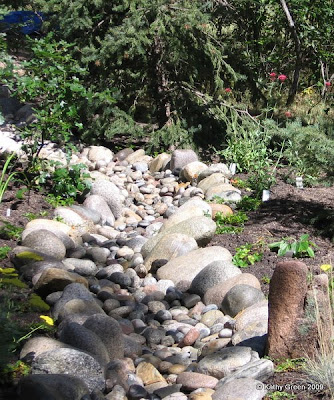Waste Not, Want Not – Creating Gardens and Landscapes that Make Best Use of Rainwater
The article below was originally written by me and published in the July 2009 Edition of Our Community News.
“Water Restrictions”, “Long-term Drought”, “Rate Increases”. These phrases all refer to our water usage, and our responsibility to use water wisely. According to the Colorado State University Extension, landscape irrigation, which includes the watering of lawns, trees, shrubs, and gardens, accounts for approximately 50% of our overall water usage. Yet, there are some very simple, legal ways to cut down on irrigation costs, use of treated water, and unnecessary runoff while still having green lawns, healthy trees and shrubs, and lots of flowers in our gardens.
Before we get into the details, it’s important to note that in Colorado, it’s illegal for most homeowners to collect rainwater to store for future use. Utah is the only state besides Colorado that does not allow homeowners to collect rain that falls on their property. The laws regarding rainwater storage go back many decades, and are in place to protect the senior water rights owned by farmers, land owners, and even states. Currently, these laws are being re-evaluated to determine if they should be changed. In fact, Governor Ritter just signed into law Senate Bill 09-80 allowing residents who are not connected to a municipal water source to collect water from their rooftops. This law took effect on July 1, 2009. There are several requirements to meet, and you must apply for a permit specifying how you will implement your rainwater collection method. If you have a well permit and are interested in more information, please go to the Colorado Government website and checkout Colorado Rain Water Bill on what the bill means to you.
So, if we can’t collect rainwater, how do we make the best use of it? There are several ways, the simplest being to divert it into your planting beds, tree and shrub areas, and lawns. This way the rain seeps slowly into the ground before leaving your property, instead of gushing into the sewers and drainage ditches, where it can cause flooding and erosion, and carry excess fertilizers, pesticides, and herbicides with it.
Let’s look at two simple ways to divert the water and design the gardens. First, you need to know your property, and how the water currently flows during a rain storm. Along the Front Range, we tend to get lots of rain in a short amount of time. This type of rain needs to be slowed down in order to make good use of it. Otherwise, it just runs right off the property. Water runs fastest in a straight line. First, watch when and where the rain flows. Then consider adding curved pathways, winding dry steam beds, depressions around garden areas, or rocks/boulders and small berms perpendicular to the flow. These will all slow down the rainwater a bit and allow it to be absorbed into the adjoining areas. Finally, plan your plantings to border these channels, and you will get extra blooms, healthier plants, and less pests and diseases.
Another simple way to use the rainwater is to direct your downspouts towards your gardens, trees, and shrubs. You can do this by using extender pipes, French Drains, dry stream beds, or gravel paths. The important thing to remember is that you still need the water to drain away from the house. Also, don’t divert this water to vegetable or herb gardens, since the water from the roofing materials may contain chemicals, high concentrations of pollution, or other unknown contaminants.
When choosing plants to take advantage of the extra water, you need to think of those that are adaptable to both wet and dry conditions. A high water needs plant will not do well in this case, because there will be periods of time when there is no water available. There are whole books devoted to gardens called “rain gardens” which use and filter the water that falls from the sky. By Googling “rain gardens”, “rainwater harvesting” or “bioswales” you will come up with lots of relevant information. Rainwater is precious, free, pure, and is worth every drop, so make good use of it!



What a great article. It's unfortunate that some states in the USA don't allow rainwater harvesting. But I'm sure common sense will prevail. I'm an avid gardener of drought tolerant plants that just survive on rainfall but I also garden some plants that require a little extra water as well so I'm lucky enough to live in Melbourne, Australia where we can harvest rainwater. I also use some of the methods you talk about. If you do as you suggest the next best place to store water other that in rainwater tanks is in rain barrels or as you suggest in the ground.
ReplyDeleteHi Mike,
ReplyDeleteThanks for the comments all the way from Australia. Yes, it is a shame that Colorado does not allow rainwater harvesting for most people. Studies have shown that up to 97% of rain water that falls on the soil never reaches the streams, but water rights laws say that every drop must be accounted for. Hopefully our laws will continue to evolve in the positive direction!
Kathy